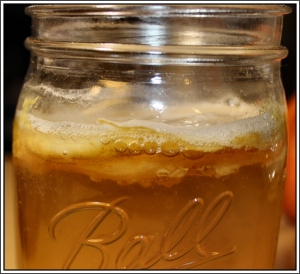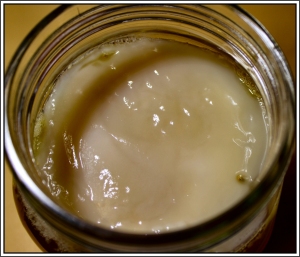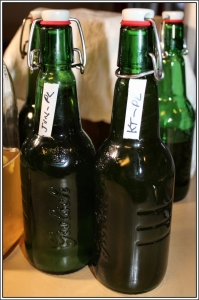Originally posted on Texas Adventures in New England in October 2012
As I continue on my fermenting and culturing journey I have found some of the most amazing, sharing, giving people. Yes, there are plenty of people selling Kombucha mushrooms or Kefir grains online but the majority of fermenters will just mail them to you or invite you to pick them up from their homes. Keeping it local is always nice and it is rarely bad to meet new people.
In addition to the probiotics that grow during fermentation, the sugar in these drinks is converted to acid giving the drinks a nice tart flavor. Adding fruit or fruit juice of some kind to the second ferment creates more probiotics and more glucuronic acid which is reputed to bind up toxins in the body so they can be flushed out. The really wonderful result of this second ferment is lots of carbon dioxide creating a delightful fizzy drink.
The Happy Herbalist is a wonderful site that lists a good analysis of what Kombucha can have in it. Jun will, of course, have different probiotics. I have been unable to find any good information on whether glucuronic acid is also produced by Jun fermentation.
Jun
Jun is one of my latest probiotic beverage adventures. The same wonderful stranger who sent me the healthiest, productive kombucha scoby sent me a Jun scoby 1.5 weeks ago.
Jun is different from Kombucha. Kombucha is made from black tea or black and green tea and sugar while Jun is made from green tea and raw honey. Each will have different probiotics and complement one another. Kombucha takes approximately 7 days for the first ferment and Jun 4 days. Jun is apparently a mystery ferment, not very common. You won’t find much information on the internet for some reason other than on forums asking about this mysterious brew. Kombucha is commercially brewed and sold raw but I do not believe Jun is available commercially yet (though I did hear someone mention buying it in California recently).
Jun scobys are much more delicate and smooth than Kombucha scobys. They grow much slower and tend to be less readily available for sharing.
I chose to use organic green tea and wildflower raw honey. After combining the tea and 1/4 cup of honey I added my little scoby and the Jun from the bag then covered with a cloth. Now I wait 4 days to try this brew that has a reputation for its zing.
First brew finished in 4 days and was perfect blend of zing and fizz. It is difficult to describe the flavor or Jun but it is like a slightly beer-like but with no grains and very little alcohol. I forgot to photograph the results of the first brew cycle.
I transferred the Jun scoby to a 1L container so the scoby can grow a little wider. Below are the results of this brew cycle.
As always, I love to experiment. When I didn’t have a Jun scoby I wondered if it was possible to grow one from Kombucha if I just used green tea and honey instead of the black tea and sugar. I decided to attempt to make Jun without a geniune Jun scoby before I received the Jun scoby from South Carolina. I grew a scoby from a bottle of GT Kombucha. I then placed that first, tiny scoby in a small batch of green tea and honey. I did this a couple more times using only green tea and honey.
I admit there are the slightest differences in the appearance of the two scobys. The Jun, however, tastes so alike that I cannot tell the difference. I am confident that the probiotics in the two batches are different to some degree. The Jun scoby is smoother than the KT turned Jun scoby. Each batch I brew using the two scobys the differences seem to be minimizing. Is my KT turned Jun geniune Jun? Not really. I will always keep the two different brews labeled.
What is a second ferment exactly? I took the Jun from both batches and rebottled them. One I added sliced ginger and the other I left plain. I then left the bottles out for another 24 hours minimum to increase carbon dioxide content (more fizz) and give the Jun time to incorporate the ginger flavor into the brew.
I label my bottled brews using medical tape (because that is what I had on hand and this tape is too thin to be useful as medical tape) a permanent marker. What is neat about this tape is that it is reusable. I just stick it to the cabinet when I wash the bottles. Update: I now just write directly on the bottles using the permanent marker. It scrubs off with hot water easily.
After the second ferment is complete the bottles are chilled in the refrigerator before serving. I use a tea strainer on top of the glass when I pour Jun, Kombucha or Water Kefir to catch the wonderful floating stuff like fruit, ginger and yeast (which are nutritious but not particularly enjoyable to drink).
I hope you are enjoying this series on fermented drinks and that you are brave enough to try them. I am convinced that after 6 months drinking Jun, Kombucha and Water Kefir it has helped my Chronic Lyme Disease symptoms enough that I started back to school in January. Of course, eliminating GMOs and eating organic has a lot to do with this healing. Cheers!








Hi Michele
JUN is very interesting. I make kombucha but would like to try culturing JUN. I can’t find anywhere that sells a JUN culture.
How did you find one. Even culturing details are non existant.
Thank you for posting your information on JUN. I’m in Australia.
How is the kombucha turned JUN culturing going. I wonder if the kombucha converted JUN will give the same nutrients as the JUN culture. the whole JUN culturing is so secretive.
LikeLike
I personally think that Jun is an adapted Kombucha culture. There is virtually no information available on the internet, no scientific details, no specific cultures that Jun is reputed to contain. I think someone put a KT scoby in green tea and honey and there you go: Jun. But this is just my own personal opinion. And I got my Jun culture from someone in South Carolina via the USPS (mail). I swapped seeds for KT and Jun scobys.
LikeLike
Hi Michelle
Your JUN culturing sounds very similar to Kombucha culturing. we have our own honey bees in the middle of suburbia so we get a variety of nectar in our honey. I’ll try using one of my kombucha scobys with green tea and our own home grown honey and see if it will culture for me.Do you put the honey in hot tea or wait till it has cooled. I thought honey would damage the scoby but obviously not.
I see that commercial ready to drink JUN is sold but no info is provided or offered.
Do you
LikeLike
I allow my green tea to cool before adding honey. I don’t want to kill anything beneficial in the honey. Some people put it in hot tea thinking that the honey itself will kill the Jun organisms. I don’t agree, but I’m not an expert. Jun is a very new ferment. No hard and fast rules at all. Maybe try to separate brews one where you add the honey to hot tea and one where you do not and see if there is any difference over time. I don’t have access to good raw honey during the winter here so I’m taking a break and have my Jun scobys in a hotel where I just feed them every once in awhile.
LikeLike
Hey Michele!
Just thought I’d comment because I’m in the midst of researching this myself; according to someone who was taught the ancient traditions, there is a BIG difference in Jun and Kombucha cultures. Kombucha uses black or green tea with sugar and generally ferments best at warmer temperatures, whereas Jun uses green tea and raw honey and likes cooler temperatures.
As far as the bacterial cultures go, Kombucha cultures sometimes have yeast in them, and Jun should not. As soon as yeast gets into a Jun culture it is no longer considered pure… this is a problem since there are so many wild yeasts that are naturally in the air around us.
You can check out the article where I found the information here: http://www.eugeneweekly.com/article/preserving-sacred-cultures
LikeLiked by 1 person
Hi Michelle
where abouts are you located. are you in Australia?
LikeLike
New England in the USA. Sorry or I would send you a Jun scoby.
LikeLike
is it the same proportions as kombucha when preparing to feed the Jun culturing.
1 litre of water
2 teasoons of green tea
1/4 cup of raw honey
LikeLike
Pretty much the same proportions: 1 quart of green tea and 1/4 cup honey. I don’t use loose tea so I’m not sure on that quantity, but that sounds about right. It’s funny that I still use quarts when my containers are marked in litres.
LikeLike
going by the time difference you’re the other side of the world.
LikeLike
Hi Michele
My converted kombucha to JUN culturing is doing nicely.
I have grown 2 very healthy scobys in the green tea and raw honey culturing.
Interesting taste. I discarded the original KT scoby. can taste the honey in the culturing. doesn’t get as sour as the KT with black tea and sugar.
my grand-daughter liked this JUN culturing. doesn’t drink the KT.
How is your JUN culturing going?
LikeLike
Congratulations on making a healthy, delicious fermented green tea. Is it jun? Probably. Still waiting for someone to do some laboratory testing on jun and declare what it is as opposed to kombucha. Still think it is kombucha that has been adapted to green tea and raw honey. So there you go. I am thrilled that your granddaughter likes this jun. My jun scobys are in a hotel waiting for farmer’s markets to start up again so I can get affordable and delicious raw honey. I bought some “raw” honey in a grocery store and it didn’t even come close to what I used last year. Can’t wait to get started again on brewing jun. Btw, jun second fermented with black cherry juice is amazing.
LikeLike
I have found that if you do not break apart the honey at all with a Jun culture, and put the honey in cool water in big chunks, it ferments a little more slowly, but that the Jun ferments & creates a delicious drink just the same, because it creates tendrils & arms that reach down and break apart the honey. In this method, I have found you end up with slightly crystalized honey particles at the bottom that are good to filter out before serving. I prefer to break apart the honey in warm water so that it will ferment faster. auroradanai@gmail.com for Q’s
LikeLike
That makes sense. I do stir the honey into the green tea to evenly distribute it in the liquid. Timing the tea so that it is warm when adding the honey makes the most sense. I still won’t put raw honey into really hot tea. I believe it will kill some of the beneficial bacteria and yeasts.
LikeLike
Hi Michele,
I am glad to see more and more people talking about Jun. As you said, there isn’t a lot of information and a lot of the information is enigmatic hear-say. So hopefully sharing experiences and blogging about it will increase the awareness and knowledge.
That said, there was some testing done at Cornell, as the article link posted above stated. Cornell has wonderful fermentation testing abilities, as they work with wineries and breweries on much more complex ferments than Jun.
Putting together information on the internet and cross checking it with my own Jun experience, I would have to say that the Jun cultures being mailed around in the US are not true Jun cultures (if there is indeed a pure jun culture). Most of the information I have come across leads me to believe that a pure Jun culture is strictly bacterial. The problem I am seeing – another post above eludes to this as well – is that the Jun becomes contaminated with yeast and other bacteria, especially because most are doing open ferments in a house that has been dominated by kombucha open ferments. More specifically, on the two different cultures I received, after 5 days of fermentation or more at 68-74 degrees F, the distinct taste and smell of vinegar was apparent, no matter how much honey was added to the ferment. That leads me to believe two things: 1. my cultures were contaminated with yeast that wasn’t suppose to be in the mix (I could clearly see it as I can on most peoples Jun pictures posted online) and 2. the yeast was creating alcohol and the acetobacter in the mix was quickly turning it to vinegar.
So it seems to me that most the cultures have been cross contaminated with Kombucha cultures and a pure Jun culture would be very very hard to maintain.
Also, on the note of “raw honey” – I know everyone’s definition is different – strictly speaking, putting honey in that has not been raised to 135-140F (this is still raw and contains the enzymes without being destroyed) there will be contamination from the honey bacteria and yeast. I tried it just be sure, and, low and behold, another fermentation layer showed up, which turned it into more of a wild mead ferment.
Since my experiments, I see more and more people talking about it so hopefully this leads to more information.
I am hoping to get my hands on another Jun culture again and experiment a little more, maybe even send it out for testing.
Thanks for sharing!
Nate
LikeLike
Great information, Nate. Appreciate you taking the time to share. I agree that the Jun I have tastes like it has some yeast in it. One jar that I forgot about tasted like champagne. Jun is fascinating.
LikeLike
Hi Michele. I am in NYC. Can you send me a Jun scooby? We can aarange details via email. Thanks!
LikeLike
I do not supply Jun scobys.
LikeLike
Hello, I’m on my second batch of Jun. I’m not sure what “taste” I’m trying to achieve since I’ve only tasted my first batch but as long as it’s pleasant I guess I’m good.
A couple of questions though. 1) I assume I can’t keep jun scoby’s in the same container with kombucha soby’s. 2) can I use the reserve liquid from the jun scoby hotel to start a new batch because I don’t continuous brew. And 3rd) most of the information I came across say’s you can’t or don’t use a kombucha scoby for jun. WELL I did and the first brew grew a very thin scoby and the second brew the scoby thickened up considerably. So 4th) do I now have a jun scoby? Any advice and or information is greatly appreciated. Thanks.
LikeLike
I am new to this, would love to learn to brew my own Jun Scoby. I want to get the best probiotics without talking supplements. Your input would be greatly appreciated. Thanks. artroberts12@gmail.com
LikeLike